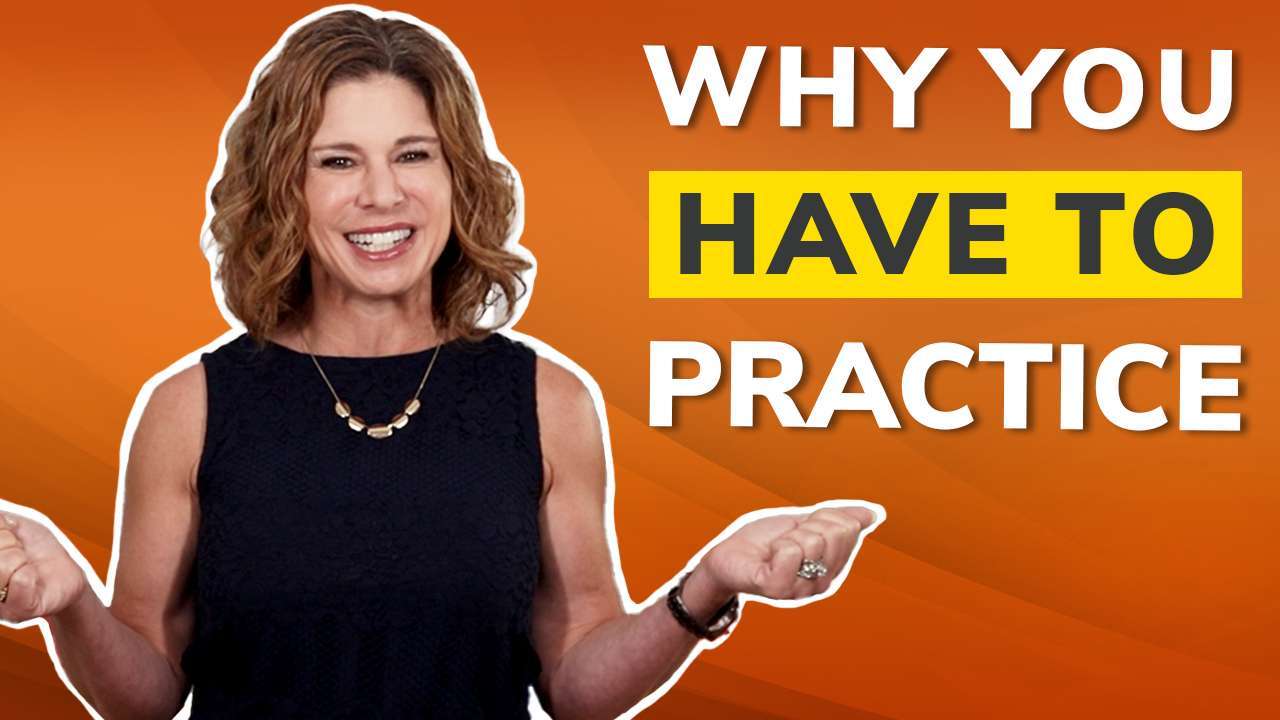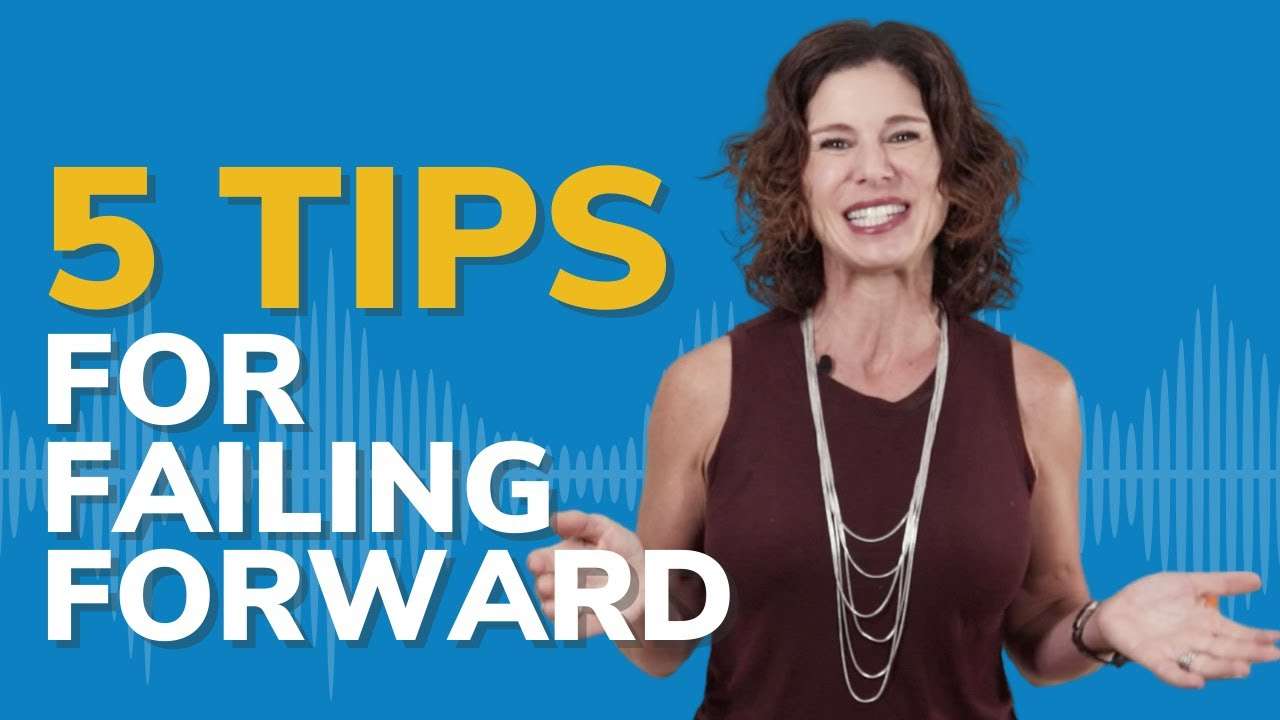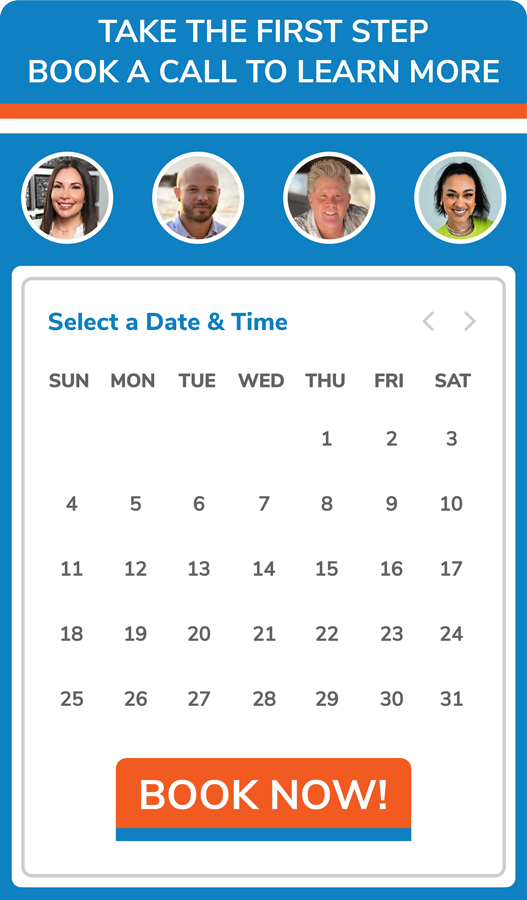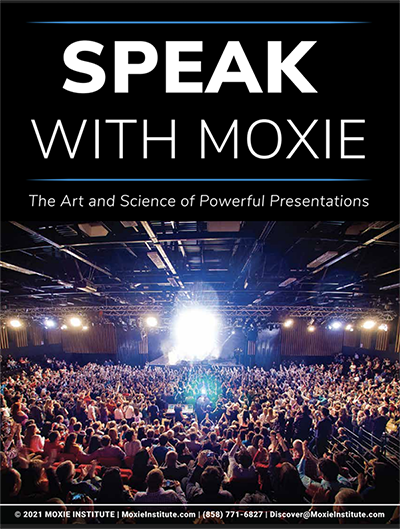Practicing for a presentation is like eating your vegetables or exercising more. It’s one of those things that most of us know is good for us and we have the best intentions of doing it and improving our lives—and then for some reason, we don’t.
Stay tuned. Today, I am going to unpack how to practice even when you don’t want to.
—
Hi everyone, I’m Fia Fasbinder. Welcome to the Moxie Talk Blog, where we help you find your voice, share your message, and lead with confidence. Today we are talking about how to practice and prepare for your presentations even when you don’t want to.
Before I get started, if you watch me on YouTube, make sure to click that alert button so you get notified whenever I put out new content. And if you enjoy the videos, please make sure to share them and subscribe to our channel.
During all of my years of working with clients, it’s always been a struggle to get people to practice their presentations. I have a few hunches why this is.
Obviously, time is one of them.
Time Constraints
People often run out of time or simply don’t have enough time because the presentation request was last minute—which I get is often the case in the real world.
They Don’t Know How to Practice
People also don’t practice or rehearse because they don’t know how, or:
Nobody Else Practices, Right?
they think nobody else is doing it, or:
I feel Awkward When I Practice
they feel super silly doing it, or:
Avoid Practice, Avoid The Anxiety of a Looming Deadline
they’re procrastinating and delaying the inevitable by avoiding it altogether.
I Don’t Practice Because I Just Don’t Want to
but the biggest reason that I found that people don’t practice is they simply don’t want to do it.
I get it—preparing and practicing for a presentation is boring; let’s face it. It takes discipline, it takes grit, and it isn’t a lot of fun most of the time. But preparation and practice is literally the most important thing you can do to guarantee your success as a presenter.
Here are a few of my favorite reasons why you should practice:
#1 Things Can and Will Go Wrong During a Presentation
Number 1, things can and will go wrong in a presentation. We can’t predict if the tech will work or if an audience member will try and derail us or if our laptop will explode in the middle of a presentation. But if we practice, we can stay the course and we’re not easily flustered by all these external forces that feel like they’re working against us.
#2 Practice Builds Your Confidence
Number 2 reason to practice—when you practice, you build your confidence because when you get up to present for the real presentation, it literally isn’t the first time you’ve delivered this. It’s the fifth, sixth, seventh time; it’s just the first time you’ve done it in front of an audience. Why would you leave an important presentation to chance for the first time in front of a real audience?
#3 Discover and Fix Mistakes in Advance
Number 3—my third reason to practice, last but definitely not least, is mistakes happen in a presentation. You want to make sure that you make those mistakes away from your audience or your stakeholders—not in front of them.
Look, nobody wants to discover that there are missing data or their slide has a typo or that they’ve said the word ‘Um!’ 17 times. If you practice, all of this occurs and can be fixed before you go live.
Here at Moxie, we are firm believers that talent is overrated and that skill trumps talent when it comes to any kind of presentation or public speaking. I oftentimes tell my clients the story of Steve Jobs.
Now most of us consider Steve Jobs to be one of the best presenters of all time but do you know that two days before every product launch, he closed shop for two days and rehearsed tirelessly? He even invited all of his staff into the theater with him to give him feedback, sometimes rehearsing past midnight.
So while you may watch his presentations on YouTube and they look off the cuff and natural, it’s actually the result of a ton of hard work and endless hours of practice so that every element from vocal delivery, emphasis, pacing, pausing, and stage movement—is timed to a T.
My rule with presenters is that nobody is better winging it. It may sound counterintuitive, but when we don’t practice we look nervous, stiff, our timing is off, and we don’t appear natural at all.
The more natural a presentation looks, the more rehearsed it actually is.
When we practice, we actually seem more off the cuff and natural because we’re able to stay present with the audience and we’re able to avoid that deer-in-the-headlights feeling of ‘I have no idea what’s coming up next in my slides’.
I know in the real world most of us don’t have the time to practice as Steve Jobs did, but we usually have time to prepare and practice one, two, maybe three times and still, we don’t do it—even though we know it will improve our presentation by tenfold.
- What is it that Steve Jobs had that kept him going and going even when the going got tough?
- How do we stay the course when we’re uninspired unmotivated out of that Rah-Rah state of ‘Yes! I’m going to practice and this is going to be great’ to ‘Oh god! this is so time-consuming and boring. I‘m just going to go off the cuff.
Now there are a lot of things that happen there so I want to give you my top 5 tips to stay motivated and practice your presentation even when you don’t want to.
Let me say that before I go into this, I’ve done several videos and blogs about how to actually rehearse your presentation and the steps of rehearsal. So if you are reading this blog and you’re feeling strong and gritty and ready to build in the mindset of a performer and an athlete and practice even when you don’t want to, check out my previous videos on the steps of rehearsal.
—
Table of Contents
Toggle#1 Find Your Why
Step number 1 is to find your ‘why.’ Study after study shows that when we tune into our why or the larger purpose of why we’re doing this presentation or why we’re doing this difficult thing, we stay the course even when it’s uncomfortable.
Intrinsic and Extrinsic Motivators
Psychologists often talk about the difference between intrinsic and extrinsic motivators. This basically means the difference between,
- Internal motivators like I want to move up from director to senior director in my company.
- External motivators like My boss is telling me that I need to lead this quarterly business review by tomorrow.
So you probably see the difference. When we find our ‘why,’ or our internal motivators or intrinsic motivators, it’s easier to keep our eye on the north star or keep our eye on that prize and do this difficult thing.
When I’m working with my clients, one thing I try to consistently drive home is that you need to find your ‘Why.’ Look, public speaking is uncomfortable and for some people, public speaking is terrifying and practice isn’t always fun. In fact, most often it’s not fun. It’s repetitive and it needs discipline. Therefore, it’s so important that you focus on something that will keep you going—focusing on your ‘Why’.
Another way to think of your ‘Why’ if you’re reading this blog and you’re thinking I have no idea what my ‘Why’ is, ask yourself this—
How is Your Presentation Serving Your Audience?
How are you contributing or serving this audience?
I mentioned some studies earlier on intrinsic motivators. There are other studies that say linking your intrinsic or internal motivator with social connection is like pouring jet fuel on your motivation. So if you’re struggling to find your ‘Why,’ think about how your presentation is contributing to or serving this audience.
I truly believe that all presenters are in a service position whether we are suggesting a new idea, providing a solution, leading the path forward to a new strategy, focusing on how you’re contributing, or serving, is the way to go.
Now I know for me, when I’m not feeling motivated to create the content for my YouTube videos or put the final touches on a new training program, I lean in hard to the audience I’m serving and how my contribution will literally improve their lives, sometimes I even visualize my audience as I’m doing this difficult thing.
—
#2 Schedule Everything
Number 2 is schedule everything. I personally live and die by my calendar, which means if it’s not on my calendar, it isn’t going to happen.
There are times that my calendar is so full that even if I wanted to squeeze in something, there are literally no free time slots. This is why I make sure that important things like practicing for a new workshop or observing one of my new trainers or even working with our slide designer to create the new slides—all of these are on my calendar.
Does this sound like you?
I know that many of us live and die by our calendars. However, there are other people that prefer to not be tied to their calendar. Here’s the thing with practice, I guarantee you that if you don’t schedule your calendar with the practices and if you don’t put this on your calendar, you’re not going to do it. It is so easy to push off practice.
Practicing Will Happen—If You Give It a Deadline
With my busy executives, when I’m doing speaker coaching with them, I make them schedule their rehearsals in front of me while I’m in their office to make sure it gets on their calendar.
Now I know that sounds harsh but it is so easy to brush things like these off, it’s so easy to schedule other things or say, Oh I’ll get around to it, and then now my calendar is too full and there’s no time. Therefore, I asked these executives to put it on their calendar and make a commitment to keep the rehearsal on the calendar and not cancel it or reschedule it unless it’s an emergency.
Rescheduling and canceling is obviously a procrastination technique. I understand that all of us are so busy and that some presentations are so last minute that you aren’t able to block off time in your calendar ahead of time. In that case, here are my thoughts on that.
Set The Rehearsal In Stone
If it’s an important high-stakes presentation that you know about ahead of time, block the time off on your calendar to practice, and don’t cancel it and don’t reschedule.
When it’s Last Minute, 1% of Practice is Better Than 0%
If it’s a last-minute presentation, can you block off an hour to get your thoughts together, to get your thoughts down on paper, put your fingers on your laptop, or even maybe run it once aloud? I truly believe that blocking off time on your calendar to do this despite all of the other demands in our crazy schedules is the best thing you can do to help yourself to commit to having a successful presentation.
—
#3 Prepare To Change The Channel
Number 3: Prepare to change the channel. When I’m coaching clients I always talk about the different voices in our heads. Most of us have a voice in our head that is full of negative thoughts telling us that we shouldn’t do certain things, or that we’re not good enough, or we’ll never be good enough, so why even try, etc. etc.
We all know this voice right? Well, I refer to this voice as a really bad DJ on a radio station called K-Crap Radio.
“Self-defeating thoughts bought to you live from K-Crap Radio!”
This DJ spews negative comments on this radio station in your head all day long. The volume on this channel gets really loud sometimes, especially when we are giving important presentations or when we’re not feeling like doing this difficult thing because it’s hard and uncomfortable, or when we’re feeling afraid.
Now, this DJ on this K-Crap Radio station is what psychologists refer to as our negativity bias, which means that we pay more attention to negative experiences than positive ones. They say that negative experiences stick in our head like Velcro and positive experiences are repelled in our head like Teflon.
Why is this?
Well, we are hardwired to pay attention to the negative. Back in our caveman and cavewoman days, doing anything scary or uncomfortable could mean sudden death. Life was dangerous back then when humans were just evolving.
In order to ensure our survival, we became hardwired to crave safety and comfort because it was a much safer choice to assume that that rustle in the nearby bush was a saber-toothed tiger, rather than just say to ourselves, Ah! it’s probably nothing. I’ll just breathe through it.
However, our modern-day brains do not know the difference between danger from a saber-toothed tiger and fear of giving a presentation. Our brain just knows fear and discomfort. Therefore, this means that when our brain is going to feel something uncomfortable or possibly unsafe, it’s going to deploy all of its tricks to get us to avoid doing that uncomfortable or possibly dangerous thing like practicing to give a presentation.
One of this DJ’s tricks on this K-Crap Radio station is to blast something in our head to get us to stop doing this thing. But we all know better, right?
If we prepare for K-Crap Radio to start blasting negative messages at us when our alarm goes off to sit down and begin working on our presentation, change the channel to your inner advocate.
we can be prepared to change the channel to a more positive radio station—the one that has the DJ that’s your inner coach motivating you and pushing you to stay the course and focus on your ‘Why,’ even when it’s difficult and uncomfortable.
—
#4 Just Show Up
Number 4: Just show up. We’ve all heard the Nike slogan ‘Just do it,’ but in my opinion, the most important part in ensuring that you do something that you don’t feel like doing is ‘Just show up.’
This is because once you’re there, whatever there means to you, it’s much harder to back down, turn around, or talk yourself out of doing this thing. Most of the time if you can just get yourself there, whether that’s to a specific room to practice or a dress rehearsal, or even back in your office in front of your computer, you’ll commit to doing the thing even when you don’t want to.
For me personally, when I’m running at 5:30 in the morning, I never want to do it.
K-Crap Radio station gets super loud in my head. As I brush my teeth and put on my workout clothes, things like ‘You should just go back to bed, one workout doesn’t matter. You can miss it. I’m not gonna make a difference anyways, I’ll just work out two days the next day.’ You know what I mean, right?
I have to turn down that voice of K-Crap Radio and literally trudge myself out the door. I know that if I force myself to get out the door, then I’m gonna do the workout.
This is no different from my clients when everything in them wants to back out of a dry run or they’re sitting down to begin crafting their presentation and they have every excuse in the book, which by the way, behind all of those excuses is usually fear. If I can just get them to go to that place, I know they’ll do it. They’ll do this thing.
By the way, once you do that thing, and in this case, that thing is practicing, you always feel better. You always feel more accomplished and more successful. Nobody has ever regretted rehearsing a presentation just like nobody has ever regretted working out or going for a run.
You never regret it after you’re done!
I always say I don’t like running, but I like to run because nobody ever says, ‘Gosh! I wish I didn’t go for that run’ or ‘I wish I hadn’t put in that hour of hard work on my talk.’ We always feel better afterward.
If you can just show up, you’ll do the work.
—
#5 Hold Yourself Accountable
Number 5 last but not least hold yourself accountable. The easiest way to make sure that we do something we don’t want to do is to make sure that someone else is relying on you.
To continue on my running story, what I didn’t mention to you is that aside from just showing up, in my driveway was that my running partner who was waiting out in that driveway for me. If I didn’t get out of bed and just left her in the dark and cold at 5:30 in the morning, she would be furious.
Have an Accountability Partner
Hence, having an accountability partner is not only a sure bet and a guarantee that you’re gonna do these hard things that you don’t want to do, but it also helps you feel part of a team or a community or something bigger than you—it’s that social connection that we talked about earlier in the blog.
Look, it’s difficult enough to do these things that we don’t want to do, but if we have somebody not only relying on us but cheering us on when we need it. it’s so much easier to stay the course if you’re holding each other accountable for different goals.
With my clients, I always encourage them to find an accountability partner that will push them and give them tough love even when they have the most clever of excuses or justifications of why they shouldn’t practice, or something else is happening in their life so they are going to back out of the practice.
This accountability partner should also have skin in the game meaning they are working on the same presentation as you or a similar presentation or they’re on your team or on a similar team so that you both continue to motivate and encourage each other even when you don’t want to practice.
There you go these are my top 5 techniques to ensure you practice even when you don’t want to. As a recap,
- Find your ‘Why’
- Schedule everything
- Prepare to change the channel
- Just show up
- Hold yourself accountable
I hope this blog is valuable. I hope it helps you go to your computer, go put pen to paper, fingers to laptops, stand up and do that hard practice, because it will definitely ensure your success.
If you found this blog to be valuable, please pass it on to somebody that you know will benefit from some little motivation on how to practice even when you don’t want to.
Last but not least if you want to find out more about what Moxie Institute does and how we can help you, check out our website, moxieinstitute.com or book a call!
Until next time, make sure to live brilliantly lead boldly, and Speak with Moxie.











